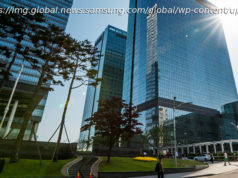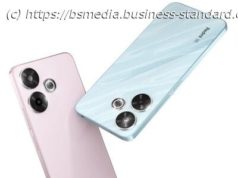Like who is it really for, how much will it cost and is it more than just a gimmick?
Samsung’s annual developer conference on Wednesday may highlight all the ways its Bixby sidekick is getting smarter, but the star of the show? Likely Samsung’s first foldable phone, rumored to be called the Galaxy F. The phonemaker is hinting hard that the foldable phone will make an appearance, even changing its logo to mimic the shape of a folding phone. But don’t expect a traditional announcement like the company’s big Galaxy S9 and Note 9 unveilings. Instead, brace yourself for a sneak peek at the phone Samsung hopes will be its next big thing.
For Samsung, its foldable phone unveiling comes at a time when the mobile world thirsts for innovation. Apple and Samsung sales are slowing down, and the global handset market is said to be “ in recession .“ Foldable phones would hurl the wow-factor into this stalling space, where even this year’s headliners, from the Galaxy S9 to the iPhone XS, vary only incrementally from 2017’s best models. As much as radical new design would shake up the flagging industry, it also raises questions about the design’s usefulness, and how easily it could stumble into gimmick territory.
„Possibly when we start selling the foldable phone, it may be a niche market, but definitely, it will expand,“ Samsung mobile chief DJ Koh told CNET in an October interview. „I’m positive that we do need a foldable phone.“
„Need“ is a strong word for any new device category, but phonemakers and pundits agree on one key benefit: more screen space. A foldable phone essentially doubles your available surface area.
It could look like two phones bound by a central hinge, or like a tablet held in landscape mode that folds closed like a book. Done right, you get a display the size of a tablet that you can carry around like a big, thick handset.
The design engenders news ways to use the phone. You might unfold it to play games and watch videos on a larger canvas. Or, you might split the screen hemispheres into separate panes for better multitasking.
For example, one display could become a virtual keyboard, while the other formed a composition window. Or, you could mirror the content on both screens and watch the same video clip across the table from a friend. And a phone that folds can prop itself up while you watch movies, no case needed. Like the earliest attempts at dual-screen phones, the Holy Grail of greater screen surface promises rich possibility.
There’s little doubt that the presence of a foldable screen in some executive’s hand — I put my money on Koh — will raise more questions than answers. Is it comfortable and practical to use, or just a gimmick? Will it be remotely affordable? What will keep it from flaming out like the „foldable“ ZTE Axon M?
Assuming that Samsung does reveal the long-anticipated foldable phone, don’t expect to get more than a glimpse and a few vague details. The Galaxy F, apparently code-named Winner, isn’t expected to land until early 2019.
Samsung will likely use this event to fire up developers and phone fans. After all, this is still a developer conference and Samsung’s chief goal will be to get app writers committed to make their programs work with a new, folding display.
„The foldable device is more of a platform than a product release,“ said Wayne Lam, principal analyst with IHS Markit. „Foldable devices will have different user experience and interface. Android is only really developed for a single mobile display.“
It’s significant that Samsung, LG, and Huawei have all shown signs of pursuing a foldable phone design. (Chinese brand Royole has already come out with the all-plastic FlexPai, which similarly folds up.)
As these powerful, portable computers continue to become the hub of people’s lives, phone-makers have struggled to increase screen size without making the device itself too large and heavy to carry in a pocket or purse.
The current trend of shrinking bezels and increasing screen size is a temporary fix that a foldable phone could potentially replace. But making two screens fold in on each other is easier said than done. A screen that can bend and flex is one thing — Samsung and LG first made „curved“ screens in 2013 and 2014, respectively — but the phones themselves didn’t bend.
Making the body of the device fold is a challenge on a much bigger scale: Batteries and components are rigid, and shifting the battery to one side can make the phone feel imbalanced. Besides that, flexible screens have been in the works for years, but thin glass can have a tendency to break more easily, especially when bent hundreds of thousands of times in a device’s lifetime.
Royole’s FlexPai solves the screen flexibility issue by using plastic instead of glass to cover the OLED display. Plastic isn’t a popular material these days, especially when you consider the price tag (the FlexPai developer models starts at $1,588). Royole put the battery on the right side, and said it balanced out the left with the other components. A rubberized hinge controls flexion on the back.
Read: Samsung mobile CEO: Our foldable phone will be a tablet you can put in your pocket
Despite design challenges, creating a bendable phone is a risk Samsung must take. Being the first major player to show off a foldable phone could help Samsung keep its footing while declining smartphone sales make the hardware titan vulnerable to the advance of its rival Huawei. The Galaxy F would also give Samsung a halo, aspirational product, like Ford’s GT supercar or Nokia’s luxury Vertu phones. Volume sales aren’t the name of the game here, but capturing attention is.
„Does the industry need to move to foldable? No, but it does open up new hybrid device category,“ Lam said, referring to a category that spans phones and tablets. (Note that the term „phablet“ was coined in response to the Galaxy Note for the very same reason.)
Samsung’s challenge is to see that its bold new designs don’t backfire and bomb. The company took a risk with the Galaxy Note series, and it ultimately paid off. Despite a rough start, Note is now an established brand with a loyal following, and the jumbo screen phone design it pioneered is now the industry standard.
Start
United States
USA — IT Samsung's foldable Galaxy F phone may appear Nov. 7, raising more questions...






